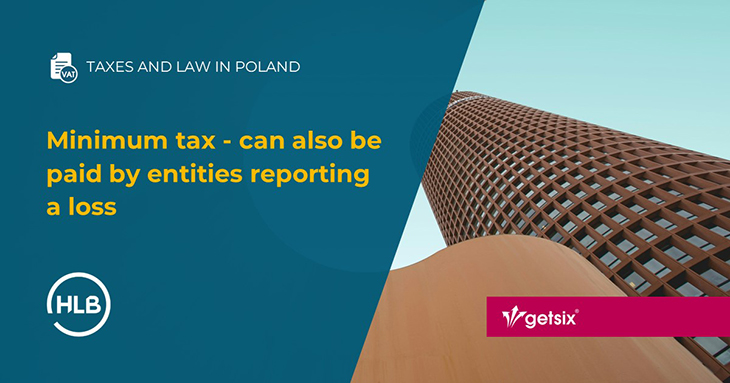Minimum tax – can also be paid by entities reporting a loss
As of January 1, 2024, regulations on the minimum corporate income tax have come into force. The purpose of the minimum tax is to tax entities that do not generate income or achieve it at a minimum level without a justified reason. However, entities reporting a loss must also pay it. Here are the key rules and regulations regarding the minimum tax.
As of January 1, 2022, provisions for the so-called minimum corporate income tax (Article 24ca of the CIT Law) were introduced into the CIT Law. These regulations came into force at the beginning of 2024 and are aimed at tightening the tax system. The minimum tax is a parallel form of taxation alongside the “classic” CIT. The year 2024 will be the first year for which certain CIT taxpayers who report a loss or very low income for the tax year will have to settle the minimum tax.
Minimum tax. Who has to pay it and who is exempt?
The minimum tax applies to:
- taxpayers who have their registered office or management in Poland, which results in tax liability on total income, regardless of where it is obtained;
- tax capital groups;
- non-resident taxpayers conducting business through a foreign branch located in Poland with respect to income and losses related to the activities of such a branch
– who, in a given tax year, incurred a loss from sources of income other than capital gains, or whose share of income from sources other than capital gains did not exceed 2% (indicating low profitability).
The minimum tax will apply to, for example, limited liability companies, joint-stock companies, limited partnerships, and under certain conditions, general partnerships with Polish tax residency that meet certain conditions.
The minimum tax regulations also provide for a number of exemptions from the obligation to apply these regulations. The minimum tax does not apply to:
- Personal income tax (PIT) taxpayers;
- Companies whose partners are solely PIT taxpayers;
- Taxpayers starting their business – in the tax year in which they started their business and the following two consecutive tax years;
- Small taxpayers whose annual gross sales revenues do not exceed 2 million EUR;
- Taxpayers who recorded a drop in revenue of at least 30% in a given tax year compared to the previous year;
- Taxpayers declared bankrupt, liquidated, or subject to restructuring proceedings;
- Taxpayers who are financial enterprises as defined in Article 15c (16) of the CIT Act;
- Entities without company status operating based on so called separate acts (e.g., cooperatives, foundations, associations, or public health care institutions).
How much is the minimum tax? Tax rates and deductions
The minimum tax is calculated independently of the classic CIT. If the criteria regarding the entity and the amount of loss or income are met, the tax amount must be calculated.
The minimum tax is 10% of the tax base, determined in a specific way. In a simplified variant, it is 3% of operating income – from sources other than capital gains. The taxpayer informs about the choice of the simplified method in the annual CIT return submitted for the tax year for which the choice was made. In the second option, the tax is 1.5% of such income, but it must be increased by certain expenses for related entities.
In practice, a CIT taxpayer might face both the classic CIT and the minimum tax obligation in the same year. However, there will be no double taxation, as the amount of the minimum tax can be reduced by the classic CIT due. Additionally, if the taxpayer pays the minimum tax, it can be deducted from the classic CIT in the returns submitted for the next three tax years.
The structure of the minimum tax provides for many exclusions and deductions. This includes the exclusion from the deductible costs of fees under lease agreements for fixed assets or from income and tax costs of the value of trade receivables sold to entities from the factoring industry. When calculating the loss and the share of income in revenues, expenses for the acquisition of fixed assets as well as revenues and cost of obtaining revenues directly or indirectly related to these revenues cannot be taken into account.
How and when to settle the minimum tax?
The tax base calculated in this way, the deductions made, and the amount of the minimum tax itself must be reported in the annual CIT return. The minimum tax must be paid in full to the account of the tax office by the end of the third month of the year following the given tax year. The structure of the minimum tax does not provide for advance payments during the year.
For the first time, entities reporting tax losses or not exceeding the 2% profitability threshold (income share in revenue) will pay the minimum tax in 2025.
getsix® – Tax advisory and CIT settlement, including minimum tax
Each CIT taxpayer must analyze whether they are in the group of entities subject to minimum tax. Unfortunately, the regulations regarding minimum tax are complicated and their interpretation can be problematic, especially since each year it must be determined if the entity, separately from the classic CIT, still meets the conditions and should also settle the minimum tax.
Therefore, it is worth using experienced tax advisors and a professional accounting office to determine who and when should pay the minimum tax and to settle it correctly. At getsix®, we will help your company settle minimum tax.
Read more about the minimum tax in the post: https://getsix.eu/getsix-blog/accounting-hr-payroll-tax-and-legal-alerts-poland/taxes-and-law-in-poland/minimum-income-tax-from-1-january-2024/.
If you have any questions regarding this topic or if you are in need for any additional information – please do not hesitate to contact us:
CUSTOMER RELATIONSHIPS DEPARTMENT

ELŻBIETA NARON
Head of Customer Relationships
Department / Senior Manager
getsix® Group
***





